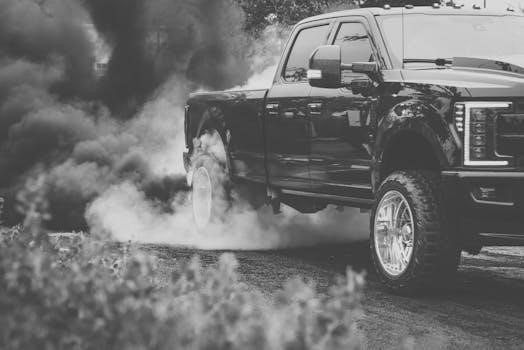This guide provides essential information about wheel torque, focusing on the importance of correctly torquing your vehicle’s lug nuts. Proper torque is crucial for ensuring wheel safety and preventing damage. Understanding torque specifications is the key to a secure wheel installation.

Wheel torque, often overlooked, is a critical aspect of vehicle maintenance and safety. It refers to the specific amount of rotational force applied when tightening the lug nuts or bolts that secure a wheel to the vehicle’s hub. Applying the correct torque is not about brute strength but rather achieving a precise tension that ensures the wheel is held firmly in place without causing damage. This process is essential for every wheel installation, whether you are changing a flat tire or mounting new wheels. Understanding the concept of torque and its proper application is necessary for ensuring the longevity of your wheel components and the overall safety of your vehicle. It also helps to prevent vibrations, premature wear, and potential wheel detachment which can lead to dangerous situations. This introduction serves as a foundation for exploring the various aspects of wheel torque and why it matters.
Importance of Correct Torque

Applying the correct torque to your vehicle’s wheel lug nuts is paramount for safety and performance. Insufficient torque can lead to lug nuts loosening over time, potentially causing wheel detachment while driving, which can have catastrophic consequences. On the other hand, over-torquing can stretch or damage the lug nuts and studs, making them weaker and more susceptible to failure. This over-tightening can also lead to issues with the wheel itself, including warping or cracking of the rim. Furthermore, inconsistent torque across all lug nuts can cause uneven pressure on the wheel, leading to vibrations, premature wear of tires and brake components, and an uncomfortable driving experience. Therefore, adhering to the manufacturer’s recommended torque specifications is not just a suggestion, but a necessity for preventing accidents and maintaining the integrity of your vehicle. By understanding and implementing correct torque practices, you ensure safer and more reliable vehicle operation.
Understanding Torque Units
Torque, in the context of wheel lug nuts, is a measure of the rotational force applied when tightening them. It’s crucial to understand the units used to express torque to accurately follow manufacturer specifications. The most common unit for measuring torque, particularly in automotive applications, is the foot-pound (ft-lb). A foot-pound represents the amount of force needed to move one pound a distance of one foot, making it a measure of twisting force. Another unit, although less frequently encountered, is the Newton-meter (Nm), which is part of the metric system. One foot-pound is approximately equal to 1.356 Newton-meters. The usage of either unit may vary depending on the vehicle’s country of origin and the tools being used. Always ensure that your torque wrench displays or is set to the correct units as per the vehicle’s manual. Using the incorrect unit can lead to significant over or under-tightening. Proper understanding and application of these units will ensure safe and secure wheel installation.
Foot-Pounds (ft-lb)
Foot-pounds, often abbreviated as ft-lb, represent a fundamental unit of torque measurement, particularly prevalent in North American automotive contexts. This unit signifies the torque resulting from a force of one pound acting at a distance of one foot from the axis of rotation. In practical terms, when you tighten a lug nut with a torque wrench set to a specific ft-lb value, you are applying a rotational force consistent with that measurement. For instance, a torque specification of 100 ft-lb indicates that you need to apply the equivalent force of 100 pounds acting one foot away from the center of the lug nut. It’s essential to use a torque wrench calibrated in ft-lb when working with specifications provided in this unit. Misinterpreting or converting from metric units without proper understanding can lead to over-tightening or under-tightening, both of which pose significant risks. Always confirm that the torque wrench is set accurately to the vehicle’s specified ft-lb value for a secure wheel attachment.
Factors Affecting Torque Specifications
Several critical factors influence the specific torque requirements for wheel lug nuts. These include wheel size and type, encompassing both the diameter and width, as different wheel designs necessitate varying clamping forces for secure attachment. Lug nut size and material also play a pivotal role; larger lug nuts generally require higher torque values, and the material composition, whether steel or aluminum, affects the torque needed to achieve the correct clamping force. Additionally, the vehicle’s make and model are essential determinants, as manufacturers specify torque settings based on engineering calculations and safety standards. Variations in these factors highlight why consulting the vehicle’s owner’s manual or a reliable torque chart is crucial; failing to consider these aspects can result in either over-tightening, which risks damaging studs or wheel components, or under-tightening, which can lead to wheel detachment. Therefore, awareness of these variables is vital for ensuring safe and reliable wheel installations.
Wheel Size and Type
The dimensions of your wheels, including their diameter and width, are significant factors influencing the required torque for your lug nuts. Larger wheels often necessitate different torque specifications compared to smaller ones. The material of the wheel, whether steel or alloy, also plays a crucial role; alloy wheels may require different torque settings than steel wheels due to their material properties. Furthermore, the design of the wheel, such as the shape of the mounting surface and the presence of a conical or flat seat for the lug nut, can impact how torque is applied and distributed. Consequently, it’s essential to consult the manufacturer’s specifications for your specific wheel type to ensure proper and safe installation. Ignoring these considerations may lead to either over-tightening, which risks damage, or under-tightening, which can cause wheel detachment. Therefore, understanding the specific requirements related to wheel size and type is paramount for safe and secure wheel mounting.
Lug Nut Size and Material
The size and material of your lug nuts are critical determinants in establishing the correct torque specifications. Lug nuts come in various sizes, typically measured in millimeters or inches, and each size has a specific torque range it can handle safely; A smaller lug nut will require a lower torque setting than a larger one. The material of the lug nut, usually steel but sometimes including alloys, also impacts the torque requirements. Different materials have different yield strengths, meaning the point at which they begin to deform under pressure. Using the wrong torque on a lug nut made of a particular material could lead to stretching, damage, or even failure. It’s crucial to consult the manufacturer’s guidelines for your specific lug nut size and material to avoid any potential safety issues. Always use the correct size and material recommended for your wheels and vehicle to ensure the wheel assembly is secure and safe. Using the wrong type or not using the specified torque may cause significant problems.

Recommended Torque Values
Adhering to recommended torque values is paramount for a safe and secure wheel installation. These values, typically provided by the vehicle or wheel manufacturer, are not arbitrary but are carefully calculated to ensure the lug nuts are tight enough to secure the wheel without overstressing the components. Using a torque value outside of the recommended range can lead to serious consequences. If the torque is too low, the wheel may loosen, leading to vibration, instability, and potentially detachment. If the torque is too high, it can stretch the lug studs or damage the wheel, making removal difficult and compromising the integrity of the wheel assembly. Always consult your vehicle’s owner’s manual, a reliable torque chart, or a professional mechanic to obtain the correct torque specifications for your specific vehicle, wheel size, and lug nut type. These values are usually expressed in foot-pounds (ft-lb) and are crucial for ensuring the long-term safety and reliability of your vehicle’s wheels.
Torque Procedure
The torque procedure is a systematic approach to tightening lug nuts to the correct specification. It’s not enough to simply tighten them; you must follow a specific procedure to ensure even distribution of pressure. Before starting, ensure that the lug nuts are clean and free of debris. Begin by hand-tightening the lug nuts in a star pattern, ensuring each is snug against the wheel. This preliminary step helps in seating the wheel evenly. Next, use a torque wrench set to approximately half of the recommended torque value. Tighten each nut in the same star pattern again. Finally, set the torque wrench to the full recommended torque value and repeat the star pattern. This staged approach prevents uneven pressure on the wheel and ensures the lug nuts are tightened properly. Avoid using air impact wrenches for final tightening, as they can easily over-torque the lug nuts. After driving a short distance, it’s recommended to recheck the torque to ensure everything remains secure.
Tightening Sequence
The tightening sequence, often referred to as a star pattern, is crucial for properly securing wheels. This pattern involves tightening lug nuts in a specific order, rather than going around the wheel in a circle. The sequence ensures even pressure is applied to the wheel, preventing warping or damage. For wheels with four lug nuts, tighten the nuts in a crisscross pattern, like a plus sign. For five lug nuts, imagine a star and tighten the nuts in a star pattern. This means tightening one nut, then skipping one, then tightening the next, and so on until all are snug. If your wheel has six lug nuts, you would follow the same star pattern concept. This method prevents uneven clamping force on the wheel which can lead to vibrations. After the initial tightening, remember to move to the next stage of torque application following the proper sequence again, and always use a torque wrench for the final tightening.
Using a Torque Wrench
A torque wrench is an essential tool for correctly tightening lug nuts. Unlike a regular wrench, it allows you to apply a specific amount of force, measured in foot-pounds (ft-lb), ensuring each nut is tightened to the manufacturer’s recommended specification. Before use, always verify that the torque wrench is properly calibrated. Begin by setting the wrench to the desired torque value. When tightening, apply a slow and steady pull until the wrench clicks or signals that the set torque has been reached. Avoid jerking or over-tightening, as this can damage the lug nuts, wheel studs, or the wrench itself. Never use a torque wrench to loosen nuts, as this can damage its calibration. Ensure the torque wrench is used perpendicularly to the nut to apply force correctly. After use, always reset the torque wrench to its lowest setting for storage. Regular calibration is important to maintain accuracy.
Consequences of Incorrect Torque
Incorrect torque on wheel lug nuts can lead to serious safety issues and potential damage to your vehicle. Under-torqued nuts may loosen over time, causing wheel wobble, vibrations, and potentially complete wheel detachment while driving. This is an extremely dangerous situation that could lead to accidents. Conversely, over-torqued nuts can damage the wheel studs or bolts, potentially stripping the threads or causing them to break. This can make it difficult, or even impossible to remove the wheel later. Over-tightening can also warp brake rotors or distort the wheel itself. Both under- and over-torquing can lead to uneven pressure distribution on the wheel mounting surface, potentially causing damage to the wheel, and premature tire wear. It is essential to use a torque wrench set to the manufacturer’s recommended specifications to avoid these problems. Always recheck the torque after the first 50 to 100 miles of driving.




